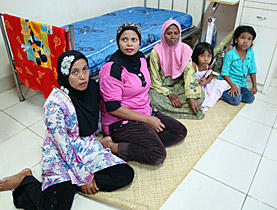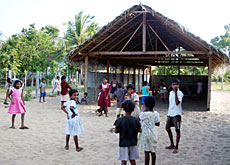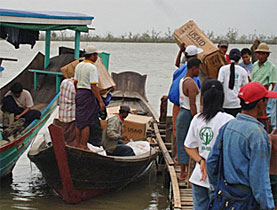Tsunami hospital faces teething problems

Nagan Raya is a brand-new 50-bed hospital in the Indonesian territory of Aceh, with state-of-the-art facilities and a noticeable shortage of patients.
Eight months after its official opening, the hospital, which was built with Swiss donations, seems half deserted, an example of the difficulty of translating good infrastructure into a working service.
This northern part of the island of Sumatra was devastated by the Indian Ocean tsunami of December 2004 and is badly in need of more medical coverage.
The district hospital for the Meulaboh region was already under construction when the tsunami struck and the work was stalled by the disaster.
The local government then asked the Swiss non-governmental organisation Caritas to get involved and Caritas took on the task with local partner Yayasan Ecosystem Lestari.
The hospital cost SFr4.7 million ($4.17 million) to build, part of the SFr220 million donated by the Swiss public in the aftermath of the tsunami. Some 100 Swiss were among an estimated 226,000 people who lost their lives in the tragedy.
Internal medicine specialist and director of Nagan Raya’s medical committee, Doctor Dirrga leads the tour around the new hospital.
Patients please
Dirrga shows us around a series of clean well-aired buildings, which boast 50 beds, including a polyclinic and a maternity unit. The young doctor proudly displays the quality of the equipment, asking us to admire the up-to-date machinery and the well-stocked pharmacy.
But there is something amiss. Where are the patients? The internal medicine service, Dirrga’s field, is catering for several tuberculosis patients and the maternity unit is even more lively because of the Indonesian tradition of the whole family accompanying the mother-to-be. But there is only a scattering of patients in the other wards.
The hospital seems half deserted, a succession of empty rooms, unoccupied beds with bare mattresses, some still wrapped in factory plastic.
Bettina Iseli, who supervises Caritas programmes in Indonesia, explains that this is a transitional period for the hospital. “In the long term the staffing problems will be solved,” she told swissinfo.
Doctors wanted
“It’s not the sick who are in short supply,” Dirrga says. “They would come in droves if only we had enough doctors to care for them. But we have great difficulty in recruiting qualified personnel who are ready to come to this isolated place.”
It is proving challenging to entice medical staff to leave Jakarta or even Medan, the capital of the neighbouring province, to come to this outlying corner of the island of Sumatra. Even the individual houses on the hospital grounds offered as residences have not persuaded them to take a posting here.
The situation will improve when newly qualified specialists from the local area, whose training is currently being paid for by the local government, return to take up positions in the hospital, Iseli explains.
Caritas is currently providing training in management, nursing, physiotherapy, emergency care and midwifery. When this training programme ends in June, the organisation will reassess the needs of the hospital and look at new ways in which it can support Nagan Raya.
But this does not mean recruiting or paying for staff. “We don’t want to take on the role of the local government, we want to support them,” Iseli says. The Swiss NGO is one of the few foreign charities active in the region.
Budget worries
Dirrga complains about the decision-making power of the local government and the amount of funding available to run Nagan Raya. The local administration sets the salaries of hospital personnel and to date the remuneration on offer has been too low to be attractive, he claims.
The result is that the hospital only has a surgeon on the premises once a week and despite the quality of the facilities, no non-scheduled or emergency operations can be carried out.
The other difficulty is the maintenance of the hospital and its equipment. Here again it is the local government that fixes the budget.
“The legislative does not support us,” Dirrga says. He reveals that hospital management has only received 10 per cent of the funds it has asked for to date. “It is simply impossible to make the deputies understand that the more modern and well-equipped a hospital is, the more expensive it is to maintain.”
High quality aid
Did the Caritas project aim too high? The NGO set out to create, in its own words, “a district hospital offering quality care at affordable prices for the local population”.
Dirrga takes the question on board. “You the donors, you want to do good, but you do not realise that here, with our limitations, your objectives are not always realisable.”
“Certainly not,” answers Hanns Polak, Bern-based head of the Swiss Red Cross programme in Indonesia. He strongly rejects the idea of bargain basement humanitarian aid. Polak stands firm: “One cannot compromise on quality.”
But he admits that the question comes up often in relation to the work of Swiss NGOs. It has also been an issue in the field of education, especially in relation to the three new Banda Aceh schools built in accordance with the strictest anti-earthquake norms.
“Our success is to have established much better infrastructure in the province than in the past,” he concludes. But at the same time he recognises that “it is not always easy to make the Indonesians understand the importance of these Swiss standards of excellence.”
swissinfo, based on an article in French by Niki Nadas
Aceh is a special territory of Indonesia located on the northern tip of the island of Sumatra. It was the closest land to the epicentre of the Indian Ocean earthquake of December 26 2004, which triggered the tsunami.
Caritas built housing for 4,000 Indonesians whose houses were destroyed by the tsunami including:
The village of 1,048 houses of Blang Beuradang in Meulaboh on the west coast to the south of the provincial capital Banda Aceh, inaugurated on March 30 in the presence of the director of Swiss Solidarity Felix Bollmann and the Swiss ambassador to Indonesia.
It rebuilt 600 houses at Singkil at a total cost SFr40 million
Built with local partner YEL (Yayasan Ecosystem Lestari), in a district of some 120,000 inhabitants on the west coast to the south of the provincial capital Banda Aceh.
Official inauguration: August 2008
Capacity: 50 beds, including maternity and polyclinic facilities
Cost SFr4.767 million

In compliance with the JTI standards
More: SWI swissinfo.ch certified by the Journalism Trust Initiative



You can find an overview of ongoing debates with our journalists here. Please join us!
If you want to start a conversation about a topic raised in this article or want to report factual errors, email us at english@swissinfo.ch.